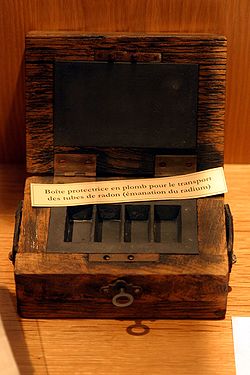
Musée Curie
Encyclopedia

Radiology
Radiology is a medical specialty that employs the use of imaging to both diagnose and treat disease visualized within the human body. Radiologists use an array of imaging technologies to diagnose or treat diseases...
research. It is located in the 5th arrondissement at 11, rue Pierre et Marie Curie, Paris
Paris
Paris is the capital and largest city in France, situated on the river Seine, in northern France, at the heart of the Île-de-France region...
, France
France
The French Republic , The French Republic , The French Republic , (commonly known as France , is a unitary semi-presidential republic in Western Europe with several overseas territories and islands located on other continents and in the Indian, Pacific, and Atlantic oceans. Metropolitan France...
, and open weekday afternoons; admission is free. The museum was closed for renovation but was reopened in the second half of 2011.
The museum was established in 1934, after Curie's death, on the ground floor of the Curie Pavilion of the Institut du Radium. It was formerly Marie Curie
Marie Curie
Marie Skłodowska-Curie was a physicist and chemist famous for her pioneering research on radioactivity. She was the first person honored with two Nobel Prizes—in physics and chemistry...
's laboratory, built 1911-1914, and where she performed research from 1914-1934. In this laboratory her daughter and son-in-law Irène
Irène Joliot-Curie
Irène Joliot-Curie was a French scientist, the daughter of Marie Skłodowska-Curie and Pierre Curie and the wife of Frédéric Joliot-Curie. Jointly with her husband, Joliot-Curie was awarded the Nobel Prize for chemistry in 1935 for their discovery of artificial radioactivity. This made the Curies...
and Frédéric Joliot-Curie
Frédéric Joliot-Curie
Jean Frédéric Joliot-Curie , born Jean Frédéric Joliot, was a French physicist and Nobel laureate.-Early years:...
discovered artificial radioactivity, for which they received the 1935 Nobel Prize for Chemistry.
The museum contains a permanent historical exhibition on radioactivity and its applications, notably in medicine, focusing primarily on the Curies, and displays some of the most important research apparatus used before 1940. It also contains a center for historical resource which holds archives, photographs, and documentation on the Curies, Joliot-Curies, the Institut Curie
Curie Institute (Paris)
thumb|Centre of protontherapyInstitut Curie is one of the leading medical, biological and biophysical research centres in the world.It is a private non-profit foundation operating a research center on biophysics, cell biology and oncology and a hospital specialized in treatment of cancer...
, and the history of radioactivity and oncology
Oncology
Oncology is a branch of medicine that deals with cancer...
.

